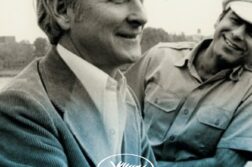Below is the second of four brief reviews of movies that appeared at the Provincetown International Film Festival in June, returning in person after a two-year hiatus. While not an LGBT festival, there are always plenty of entries that match this magazine’s mission.
 ALL MAN: The International Male Story
ALL MAN: The International Male Story
Directed by Bryan Darling and Jesse Finley Reed
The Film Collaborative
If you’re over forty, chances are you received International Male in the mail at some point in your gay life. You may have tossed it aside as just a clothing catalog, or you may have dived right in to check out the latest bevy of models. The “magazine/catalog” started publishing in the mid-1970s at a time when Sears and Macy’s were still airbrushing men’s bulges out of underwear ads. Not so International Male, which began to present men in a whole new way—not as clean-cut, generically handsome men but as scruffy guys with muscles and body hair and bulges in all the right places.
Even those who devoured the IM catalog may question the need for a feature-length documentary about it (as I did). It turns out IM has a fascinating story to tell, and it may even have played a role not only in expanding the range of fashion options for men but even in shaping ideas about masculinity itself. Sure, some of the clothes it featured were outlandish or even trashy, but they were eye-catching for those who wanted to make a splash, say, at the dance club or on the beach.
IM was the vision of Gene Burkard, who was gay himself and recognized the potential for the gay market. Nevertheless, Burkard decided early on never to use the “g” word or to imply that the models depicted, or the audience targeted, were primarily gay men. The models were manly men without a hint of effeminacy or narcissism. Fashionista Carson Kressley points out in the film that here was a spectacle of ultra-butch models wearing some pretty feminine outfits. (Apparently it was often hard for the models, most of whom were not gay, to keep a straight face, as it were, during photo shoots.)
The strategy of avoiding any direct appeal to gay men seems to have paid off. At times up to 75 percent of IM buyers were women buying clothes for their husbands or boyfriends. The upshot is that many straight men started wearing colorful sports shirts and undies that were not tidy whiteys—and the metrosexual was born. The impact on the gay community was undoubtedly greater still. The IMcatalog created a mainstream outlet that presented an image of masculine men who were assumed (or imagined) to be gay—and the clone was born.





